- GO Enhanced, Irradiation Cross-linked UHMWPE/VE Nanocomposites with Increased Hardness and Scratch Resistance
Binjiang College, Nanjing University of Information Science & Technology, Wuxi 214105, China
*School of Mechanical Engineering, Jiangnan University, Wuxi 214122, China- GO 강화 및 조사 가교된 UHMWPE/VE 나노복합재료의 경도와 스크래치 저항의 증가
In this study, a way to
reinforce the properties of ultrahigh molecular weight polyethylene
(UHMWPE)/vitamin E (VE) nanocomposites was put to use by adding graphene oxide
(GO) combined with gamma-ray irradiation cross-linking. The influences of
adding GO and irradiation cross-linking treatment on the thermal and mechanical
properties were studied, especially the effect of GO doping on irradiation
cross-linked UHMWPE/VE nanocomposites. The results show that GO filling has no
significant effect on melting temperature and gel content decreased at a small
degree, but the crystallinity has been improved obviously. In addition, the
ball indentation hardness and scratch resistance were enhanced as well. The
comprehensive effects of improved crystallinity and reduced cross-linking
degree as well as the good mechanical properties of GO doping were responsible
for this result.
A way to reinforce the properties of ultrahigh molecular
weight polyethylene (UHMWPE)/Vitamin E (VE) nanocomposites was put to use by
adding graphene oxide (GO) combine with gamma-ray irradiation crosslinking. GO
filling has no significant effect on melting temperature and gel content
decreased at a small degree, but the crystallinity has been improved obviously.
In addition, the ball indentation hardness and scratch resistance were enhanced
as well.
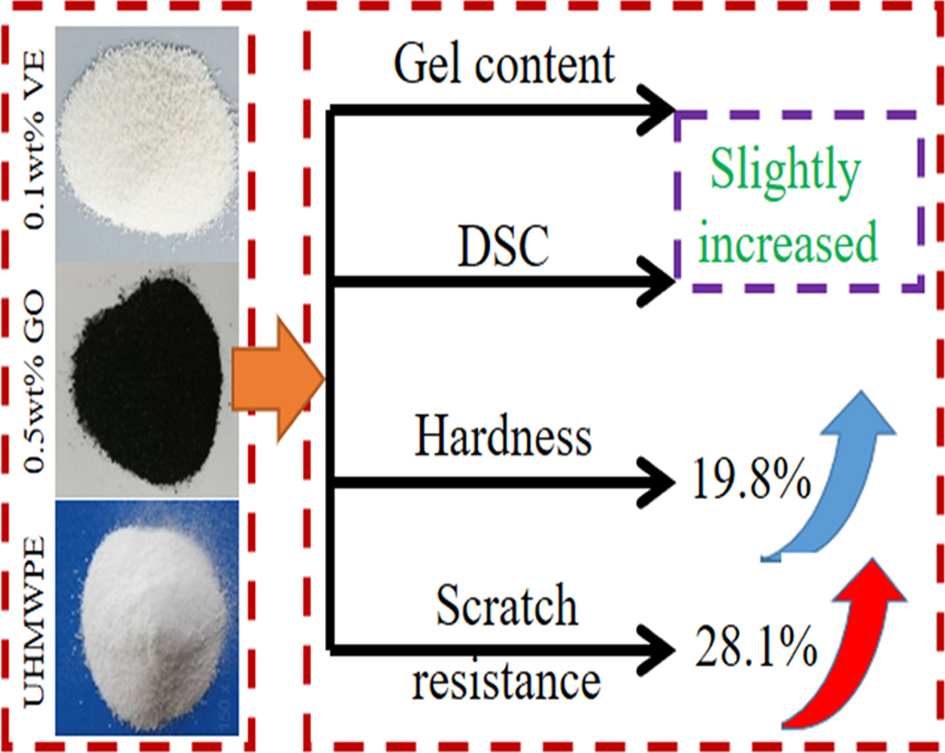
Keywords: graphene oxide, UHMWPE/vitamin E nanocomposites, irradiation cross-linking, hardness, scratch resistance
This study is supported by the Additive Manufacturing
Products Supervision and Inspection Center of Jiangsu Province, Wuxi
Institution of Supervision & Testing on Product Quality, Wuxi, China.
Irradiation cross-linked ultra-high molecular weight polyethylene/vitamin
E (UHMWPE/VE) composite has been widely used in total joint arthroplasty (TJA)
as its excellent thermal stability, anti-oxidation and wear resistance.1
However, the existence of VE would stabilize and absorb free radicals generated
during irradiation process, which results in the decrease of cross-linking
degree of the composite. The decline of cross-linking degree will lead to the
decrease of mechanical properties, such as hardness and scratch resistance, and
bring about adverse effect to the joint prosthesis in the long-term service. In
order to solve those problems, researchers have devoted a lot of efforts, such
as Yang and Lee.2,3 Oral et al. studied the irradiation
cross-linked UHMWPE blends with 0.1 wt% and 0.3 wt% VE respectively,
the result shows that although the oxidation resistance increased,
cross-linking degree of the material decreased with the increase of VE content,
and mechanical properties reduced as well.4,5 Besides the
cross-linking degree, crystallinity is also one of the factors affecting the
properties of materials. Oral et al. showed that the tensile and fatigue
properties of irradiated cross-linked UHMWPE/VE composites are linearly and
positively correlated with the crystallinity.6 Doshi et al. improved
the crystallinity of irradiated cross-linked UHMWPE/VE composites to ameliorate
the fatigue resistance and tribological properties by high pressure
crystallization process.7 Fu et al. researched the influence
of high temperature melting treatment on irradiation cross-linked UHMWPE/VE
composites, the results show that high temperature melting improved the
crystallinity, wear resistance and impact properties also enhanced company with
increased crystallinity.8 Although above methods improved the mechanical
and tribological properties to some extent, the high cost and tedious process
in the preparation process limited large-lot production. Therefore, there are
badly in need of a more advanced technique to modify irradiation cross-linked
UHMWPE/VE composites.
Graphene with good biocompatibility, mechanical properties and large
specific surface area, has been widely applied as a modifier to enforce polymer
matrix.9-12 However, the characteristics of easy clustering and
unfavorable dispersal restrict its application. Graphene oxide (GO), a
functionalized product of graphene, with excellent dispersion, thermal
stability and mechanical properties, has been used as a reinforcing agent for
UHMWPE material in recently years. Pang et al. fabricated 0.5 wt%
UHMWPE/GO composites by hot-pressing, and found that GO is well dispersed in
UHMWPE matrix.13 Moreover, the addition of GO improved not only the
thermal performance and crystallinity, but also the hardness of the composites.
Ni et al. investigated irradiation cross-linked UHMWPE by adding
0.5 wt% GO, showing that the addition of GO slightly increased the melting
temperature, but significantly increased the crystallinity.14 Huang et
al. studied the irradiation cross-linked GO/UHMWPE composites, and drew a
similar conclusion.15,16 Moreover, the results demonstrated that GO
could maintain the efficiency of cross-linking. Furthermore, the mechanical,
wear and anti-scratch properties enhanced as well. Besides, other researchers
also demonstrate that GO could improve the hardness and wear resistance of
UHMWPE.17-19
Based on those results mentioned above, we add 0.5 wt% GO into
0.1 wt% UHMWPE/VE composites before irradiation cross-linking. Looking
forward to maintaining the cross-linking degree of composites, meanwhile, with
excellent thermal stability and higher crystallinity to improve mechanical
properties of materials. In order to confirm whether the mechanical properties
of irradiation cross-linked UHMWPE/VE/GO composite can be strengthened or not,
the ball indentation hardness and scratch test are carried out. Since it is
closely related to the mechanical properties of materials, melting temperature,
crystallinity and cross-linking degree are also investigated in this study.
Materials
and Materials Preparation. Powdered UHMWPE
(GUR1050) has a density of 0.93 g·cm-3 with an average
molecular weight of five million and the mean particle diameter of about
140 μm, and was purchased from American Ticina Company. High-purity
graphite powder (99.9 wt%, 325 mesh) was provided by Qingdao Jinrilai Co.
Ltd. China, and was used to prepare GO. Other chemical reagents were analytical
grade and were supplied by Sinopharm Chemical Reagent Beijing Co., Ltd.
GO was prepared in accordance with the modified Hummers method.20
The irradiation cross-linked UHMWPE/VE/GO composites with the concentration of
0.1 wt% VE and 0.5 wt% GO was fabricated by means of liquid
ultrasonic dispersion, high speed ball milling, hot pressing molding and
irradiation cross-linked by γ-ray, the detailed steps are as follows: First of
all, 0.1 g VE and 0.5 g GO powder were placed in a beaker with
100 mL alcohol solution and ultrasonic treated for 0.5 h, then
99.4 g UHMWPE powder was added into the beaker and continue ultrasonic
treated for 1 h to obtain a homogeneous solution. Secondly, the mixed
solution was treated by high speed ball milling at a speed of 400 rpm for
2 h and then kept in a water bath at 60 oC to remove the
ethanol until the alcohol was completely evaporated. Thirdly, the mixture
powder was pressed in a model at 5 MPa for 0.25 h followed by heating
treatment at 200 oC for 2 h in a hot air oven, and then
pressed at 10 MPa until reached room temperature. Finally, the specimens
were cut into different sizes of samples then vacuum packed and irradiated by γ-ray
at a rate of 0.5 KGy/h at room temperature, the total irradiation dose was
100 KGy.
Gel
Content. According to ASTM D2765-01,21
the gel content after irradaition cross-linking of UHMWPE/VE/GO composites was
calculated in terms of the following formula.

where W0 is the quantity of sample before test, W
is the quantity of sample after test.
Differential
Scanning Calorimeter (DSC). DSC (TA, Q200) was
applied at a scanning rate of 10 oC/min from 20 to 200 oC
in the nitrogen atmosphere. The samples were heated to 200 oC
and held for 5 min to remove thermal history; then they were cooled to 20 oC;
finally they were heated to 200 oC. The crystallinity of
UHMWPE/VE/GO composites was calculated according to the following formula. The
crystallinity of UHMWPE/VE/GO composites before/after irradiation cross-linking
was calculated according to the following formula.

where f is the filler
content, DH is the melting
enthalpy of samples and DH0 is the enthalpy of
melting of a 100% crystalline UHMWPE with the data of 293 J/g.22
Ball
Indentation Hardness. The ball indentation hardness
of different composites were measured by the MFT-5000 tribometer and calculated
by the following equation according to the standard ISO2 039-73.23

where H is the indentation hardness of samples (N/mm2);
p is the maximum experimental force (N); D is the diameter of the
ball (mm); h is the maximum indentation depth (mm). The diagrammatic
sketch of ball indentation hardness test is shown in Figure 1.
Scratch
Test. Scratch resistance is also a way to evaluate the
mechanical properties of materials. In this paper, the scratch test of
different composites was also measured by the MFT-5000 tribometer, the scratch
coefficient is calculated by the following equation.
where μ is scratch coefficient; FT is the
scratch resistance; FN is normal pressure. The diagrammatic
sketch of scratch test is shown in Figure 2.
The experimental load is 1 N with 12 mm scratching length at a
speed of 0.2 mm/s, MFD-D profilometer was used to scan the scratch
morphology after test. Diagrammatic sketch of parameters for scratch test is
shown in Figure 3.
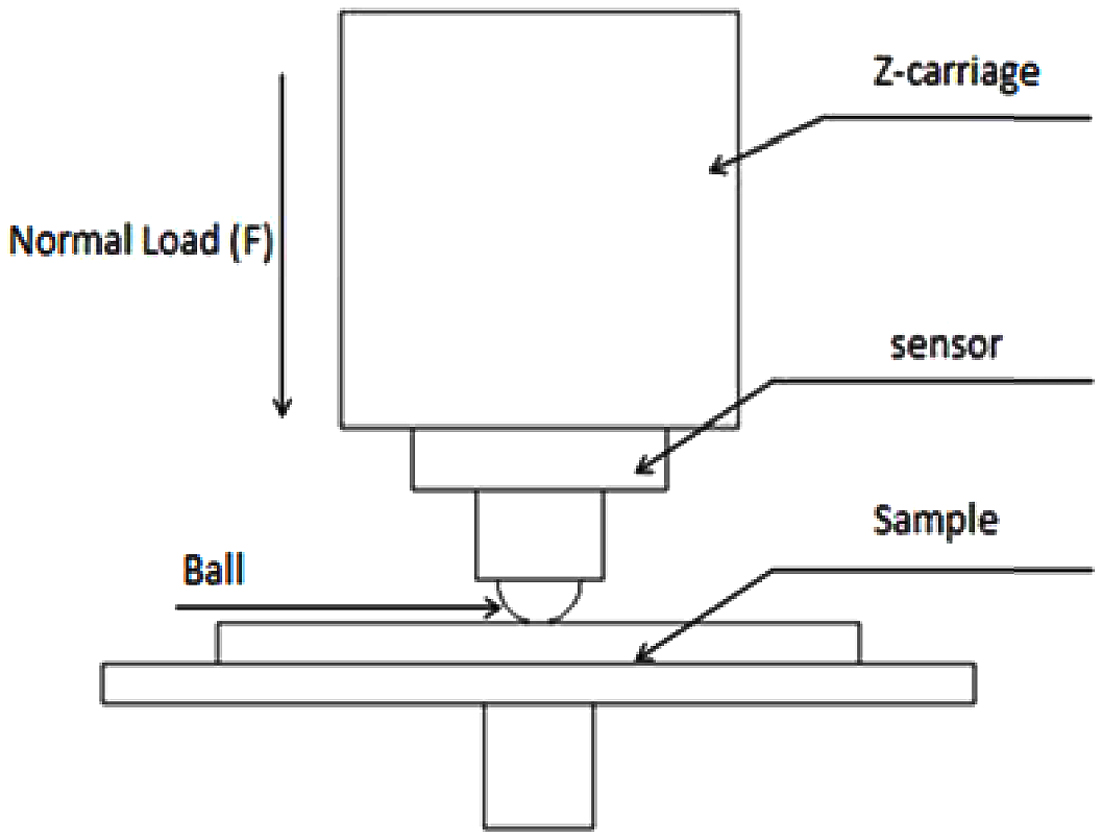
|
Figure 1 Diagrammatic sketch of ball indentation hardness test. |

|
Figure 2 Diagrammatic sketch of scratch test. |
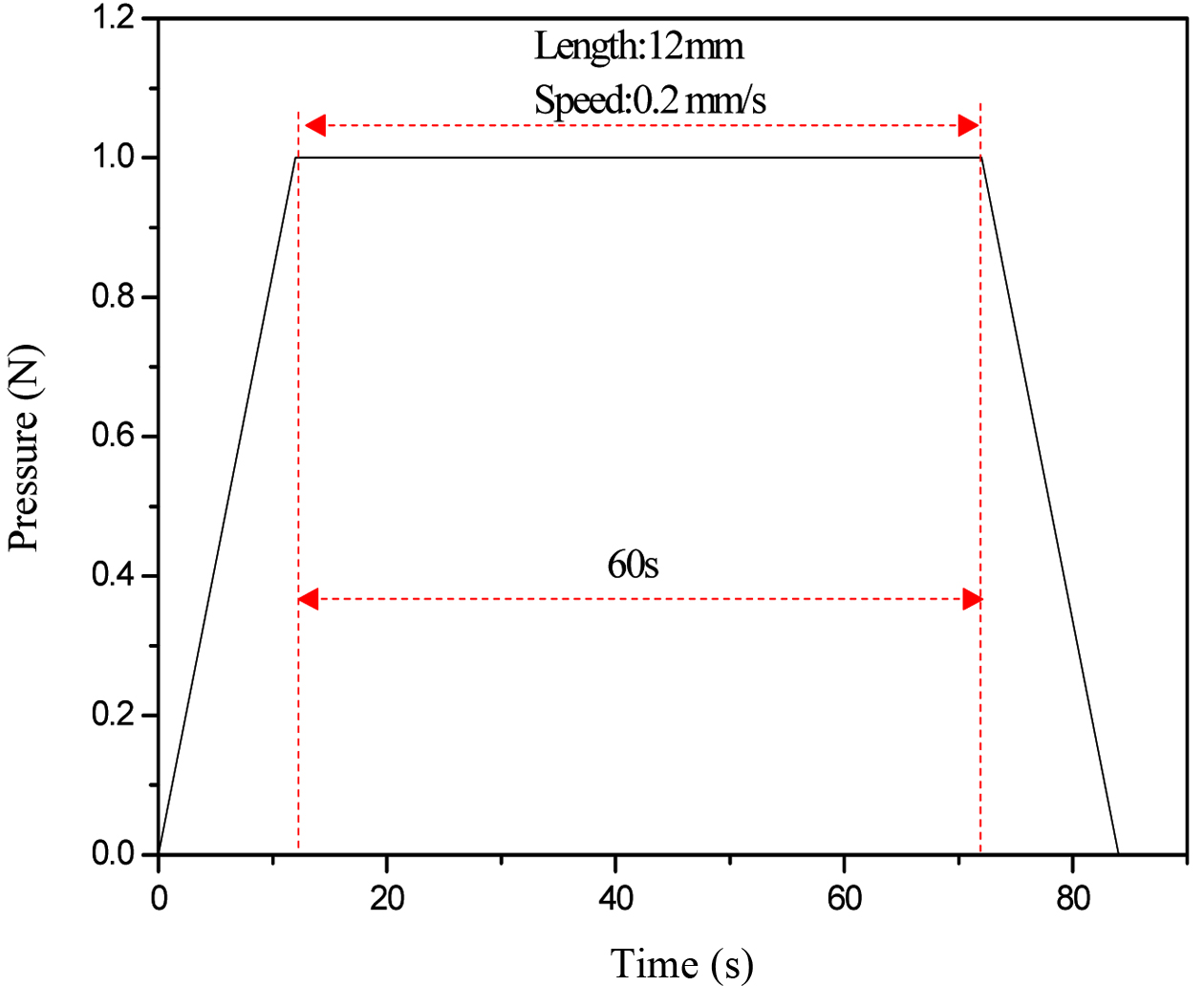
|
Figure 3 Diagrammatic sketch of parameters for scratch test |
As substrate material for artificial joints, UHMWPE composites will
release heat which could affect the properties of materials due to friction in
long-term applications, in order to characterize the thermal stability of
irradiation cross-linked UHMWPE/VE/GO composites, the melting temperature and
crystallinity of different composites were studied by DSC, as shown in Figure
4-6 Figure 5 and Table 1. It should be noted that our previous research results show
that no degradation of VE occurred at this temperature condition.24,25
It can be seen that the melting temperature of pure UHMWPE was 133.7±0.3 oC,
the filling of VE and GO has unobvious effect on the melting temperature of
UHMWPE. Pang also illustrated the similar results that the filler of both VE
and GO has no significant impact on the melting temperature of UHMWPE.25
After irradiation cross-linking, the trend is almost the same to that of
non-irradiated UHMWPE composites. The melting temperature of both UHMWPE and
its composites were almost constant, this was due to the cross-linking reaction
of the fractured molecular chains in the amorphous region during irradiation,
which delays the melting process and increases the melting temperature.26
GO has capable of grafting to the molecular chain of irradiation cross-linked
UHMWPE/VE composites as its larger specific surface area, which could be able
to enhance interface adhesion of the composites.27 Therefore, the
melting temperature nearly remain unchanged.
As shown in Table 1, the crystallinity of pure UHMWPE was 50.8±1.5
followed with 50.7±1.2 after adding VE, showing that VE filling has no obvious
effect on the crystallinity of UHMWPE, this result was analogous to the
findings of other researchers.28 A significantly increased
crystallinity emerged in composites after filling GO, compared with that of
unfilled. GO can turn into nucleation sites for crystallization as its large
specific surface area. In the crystallization process, GO gradually transforms
from microcrystalline region to larger crystal region around UHMWPE, which
promotes the increase of crystallinity of UHMWPE matrix. In addition, it can be
found that irradiation cross-linking not only increased melting temperature but
also crystallinity. A large number of fractured molecular chains recrystallized
to form more perfect crystals during irradiation, resulting in increased
crystallinity. Meanwhile, the crystallinity of irradiation cross-linked UHMWPE
was almost the same regardless of whether adding VE or not, showing that VE
hardly affects the change of crystallinity. However, the crystallinity improved
4.8% compared with irradiation cross-linked UHMWPE/VE composite after GO
filling. On the one hand, irradiation cross-linking disrupts the linear
molecular chain of UHMWPE and recrystallizes the broken molecular chain. On the
other hand, two-dimensional wrinkled GO with large specific surface area may
play a role in hindering the mobility of fractured molecular chains, gathering
on the surface of GO and increasing the recrystallization process.26
It is reported that the increase of crystallinity is beneficial to the
improvement of mechanical properties of UHMWPE matrix.6,7,29 Therefore,
the experimental results provide an effective theoretical support for further
study on the mechanical properties of irradiated cross-linked UHMWPE/VE/GO
composites.
To a certain extent, cross-linking of composites can improve mechanical
properties. Therefore, for the sake of characterizing the cross-linking degree
of irradiated cross-linked UHMWPE/VE/GO composites, the gel content of the
composites was tested, as shown in Figure 7. The gel content of irradiation
cross-linked UHMWPE was 90.25% and with 2.9% decline after adding VE, the
result was similar to Oral.5 This was due to the ability to absorb
and stabilize free radicals of VE, hindering the cross-linking of free
radicals. After adding GO, the gel content of the irradiated cross-linked
UHMWPE/VE/GO composite decreased slightly, but it was not obvious. This may be
that the mobility of fractured molecule chain was hindered by the strong
interface binding force between GO and UHMWPE/VE matrix.14,26 Once
more, to some degree, GO composite has the function of scavenging free
radicals. In addition, Hyun studied the effect of g-rays on the
crystallinity of UHMWPE under different crystallization conditions.30
It was found that the crystallinity of UHMWPE increased whereas the amorphous
region of UHMWPE decreased, limiting the cross-linking of UHMWPE.31
To be specific, GO has moderating effect on gel content influencing the
composites, but the effect is not very significant.
Figure 8 shows the ball indentation hardness of irradiation cross-linked
UHMWPE/VE/GO composites. It can be found that the filler of VE reduced the
hardness of UHMWPE slightly, but the hardness of the composites increased
significantly after GO filling. The hardness of pure UHMWPE is 26.43 MPa,
then decreased to 25.21 MPa after filling VE and increased to
28.86 MPa after filling GO. This was owing to the excellent mechanical
properties of GO, its wrinkled two-dimensional structure can withstand part of
the loads and transfer them to a larger layered structure.13-16,26
Although the hardness of the composites decreased after filling VE, the
addition of GO played a dominant role, and the combined effect of those two
factors resulted in the increase of the hardness. Irradiation cross-linking
increases the hardness of pure UHMWPE by 7.9%, and the hardness of irradiation
cross-linked composites changed from 27.34 MPa to 30.03 MPa after
filling VE and GO, respectively. This is due to the absorption of free radicals
by VE, resulting in the decrease of cross-linking degree.26 Although
the cross-linking degree of irradiated cross-linked UHMWPE is reduced by adding
VE, which is not conducive to the increase of hardness, UHMWPE inevitably
oxidizes and becomes brittle during irradiation process, which also reduces the
hardness of the material. The existence of VE effectively improves the
oxidation resistance of the material, and the two functions make the hardness
decrease in a very small range. As the excellent mechanical properties of GO,
the irradiation cross-linked UHMWPE/VE/GO composite possesses optimal hardness
compared with other materials. Furthermore, Buchanan pointed out that
the hardness of material is closely related to its crystallinity and increases
with the increased crystallinity, which is similar to our research.31
In addition, although GO filling slightly reduces the cross-linking density of
irradiation cross-linked UHMWPE/VE composites, whereas improves the hardness,
indicating that crystallinity plays a leading role in improving hardness of the
materials.
Figure 9 and Figure 10 show the scratch coefficient and morphology of
irradiation cross-linked UHMWPE/VE/GO composites, the specific data are shown
in Table 2. The result shows that the mean scratch coefficient vary from 1.01
to 1.21, and hardly changed after adding VE. It can be found that the addition
of VE has no effect on the scratch coefficient of pure UHMWPE, which is mainly
due to the unchanged crystallinity. However, the addition of GO led to an
increase of scratch coefficient of 11%. The wrinkled two-dimensional structure
of GO and the increased hardness of composite increase the sliding resistance
of probe in the matrix, the tiny van der Waals force between GO slice and
UHMWPE matrix is also one of the reasons for the increase of scratch coefficient.13
After irradiation cross-linking, the mean scratch coefficient increased to
1.17, it can be attributed to the cross-linking degree. The molecular chains
interrupted by γ-rays are recombined and cross-linked, which increases the
crystallinity and cross-linking degree of the matrix, the increase of hardness
resulted in the increase of scratch coefficient.15,16 Compared with
irradiation cross-linked UHMWPE, the scratch coefficient is reduced by 3% after
filling VE, this is mainly due to the decrease of cross-linking degree. The
irradiation cross-linked UHMWPE/VE/GO composite possesses maximum scratch
coefficient. On the one hand, the increased cross-linking degree and the
addition of GO increase the sliding force of probe, respectively. On the other
hand, while the UHMWPE molecular chains are interrupted during irradiation
process, the GO molecular chains are also interrupted generating GO free
radicals simultaneously, partial GO free radicals react with UHMWPE radicals to
form C-C bonds.14 The bond energy of the generated C-C bond is much
stronger than that of the van der Waals force, resulting in increased interface
bonding force, which further increased the scratch coefficient. Consequently,
those above factors result in the biggest scratch coefficient of the
irradiation cross-linked UHMWPE/VE/GO composite.
Compared with scratch coefficient, scratch depth presents the opposite
results, the scratch depth decreased from 22.8 to 16.4 μm, as shown in
Table 2. UHMWPE possesses the biggest depth, the addition of VE had no obvious
effect on the scratch depth of pure UHMWPE, however, irradiation cross-linking
and GO filling reduce the scratch depth obviously. The reason for this
phenomenon is similar to that of scratch coefficient.
Besides, another reason for the improvement of mechanical properties may
be nanoinclusion and nanoconfinement effects caused by the addition of GO, as
reported by Kim and Choe.32,33 After adding 0.5 wt% GO, composites
reveal improved mechanical properties owing to strong polymer–filler
interactions by virtue of large contact area caused by GO nanosheets. Since
nanoinclusion and nanoconfinement effects of interface boundary, UHMWPE polymer
and GO nanosheet composites have a very broad application prospects in
strengthening mechanical properties by increasing the interfacial area.
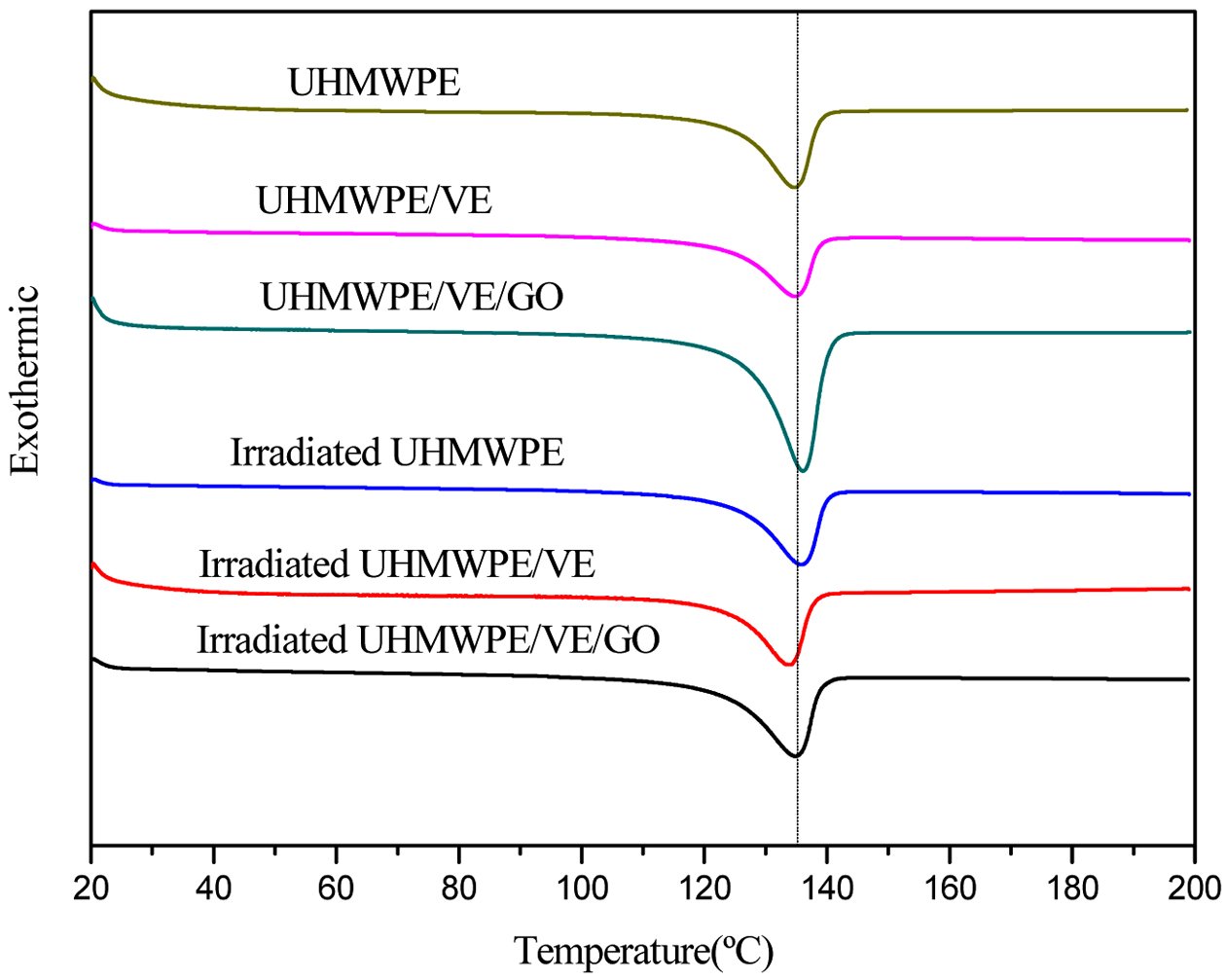
|
Figure 4 DSC curves of different materials. |
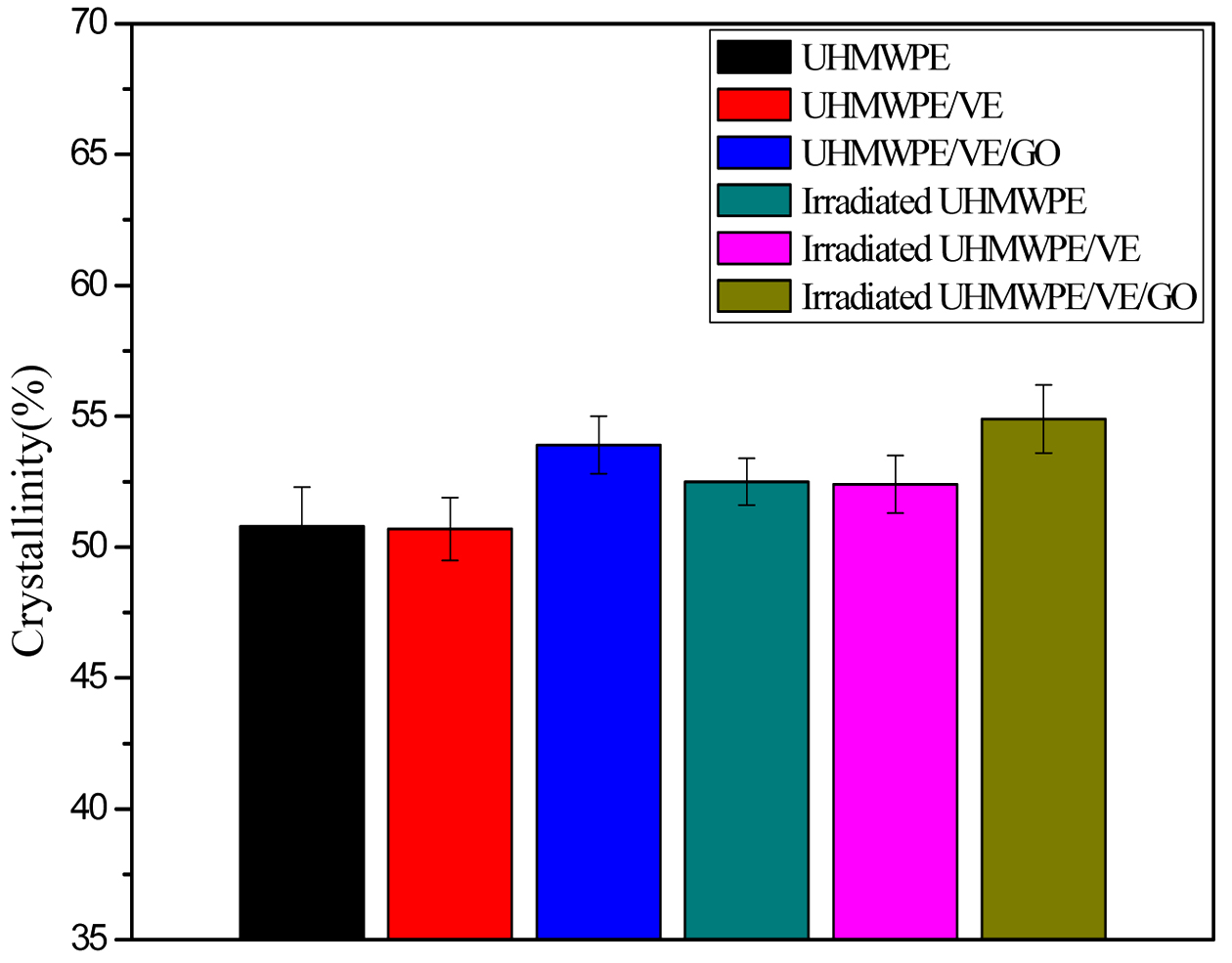
|
Figure 6 Crystallinity of different materials. |
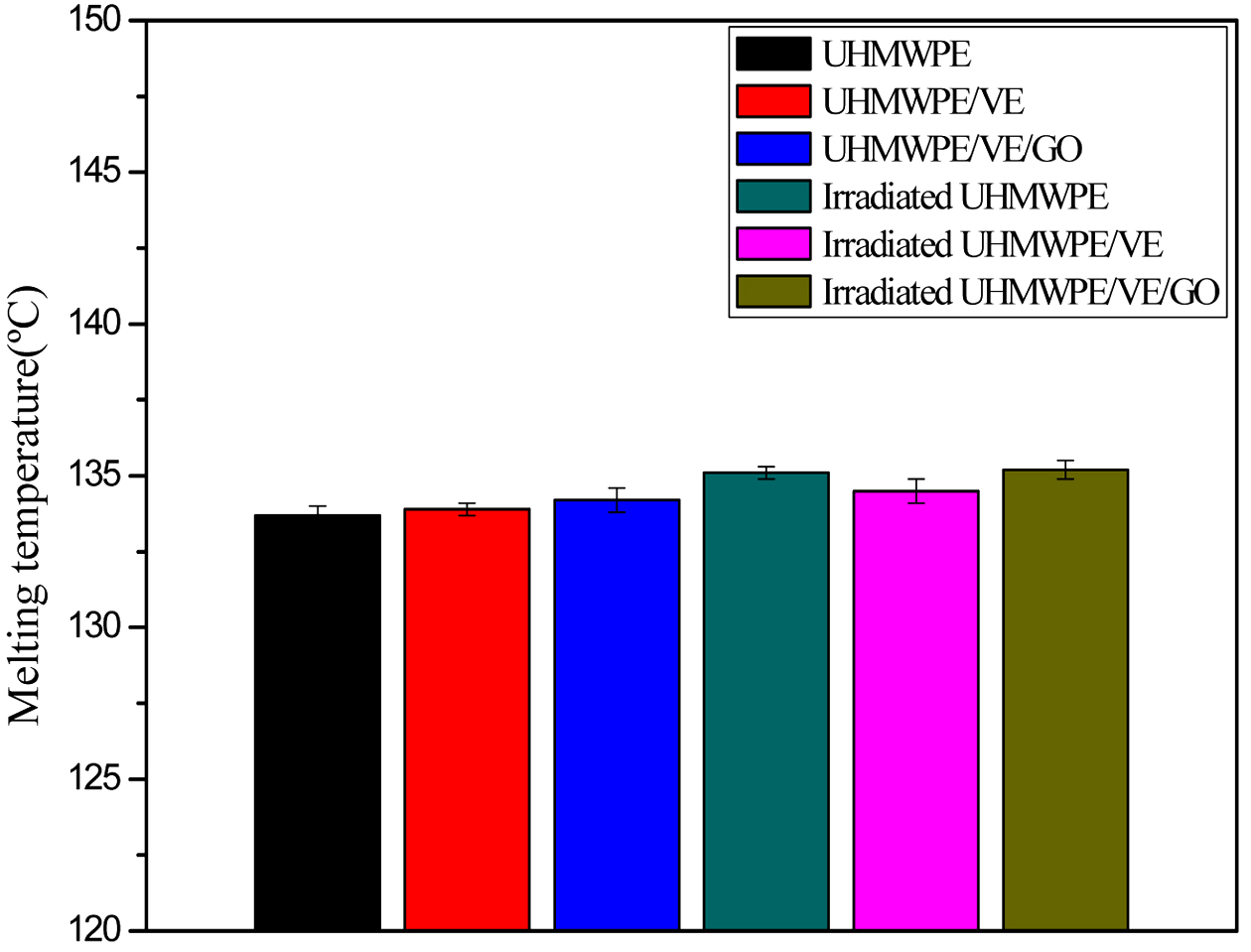
|
Figure 5 Melting temperature of different materials. |
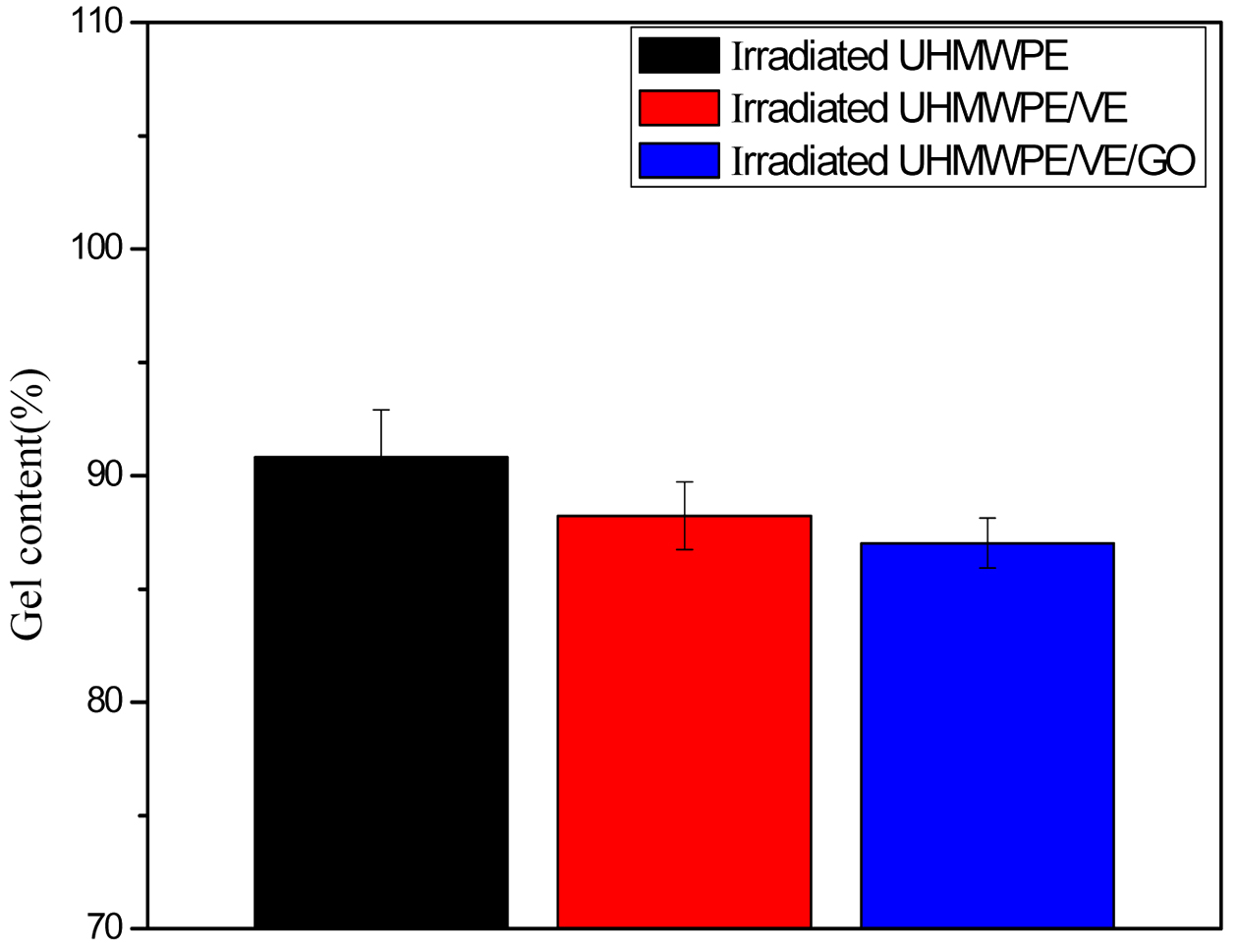
|
Figure 7 Gel content of different materials. |
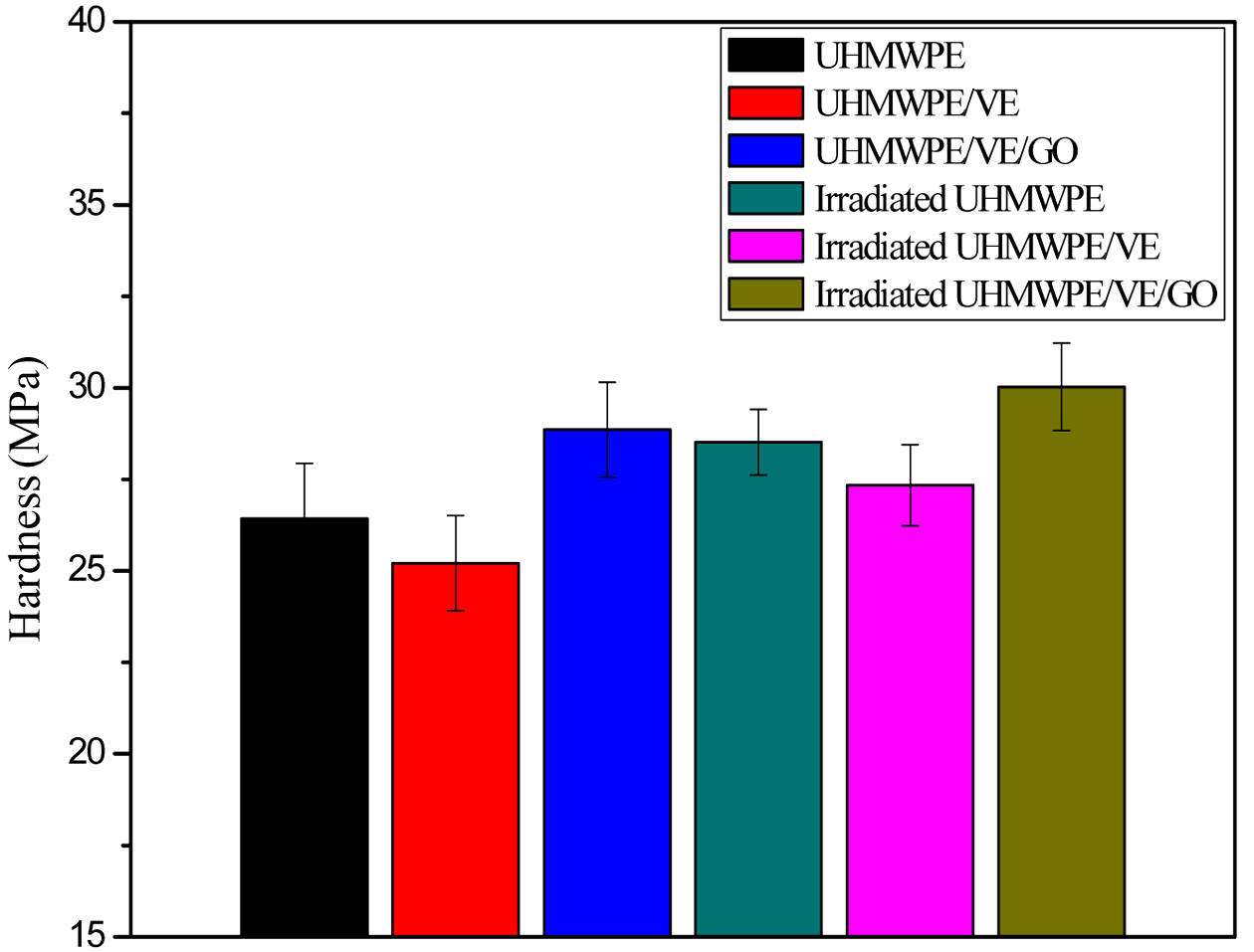
|
Figure 8 Ball indentation hardness of different materials. |
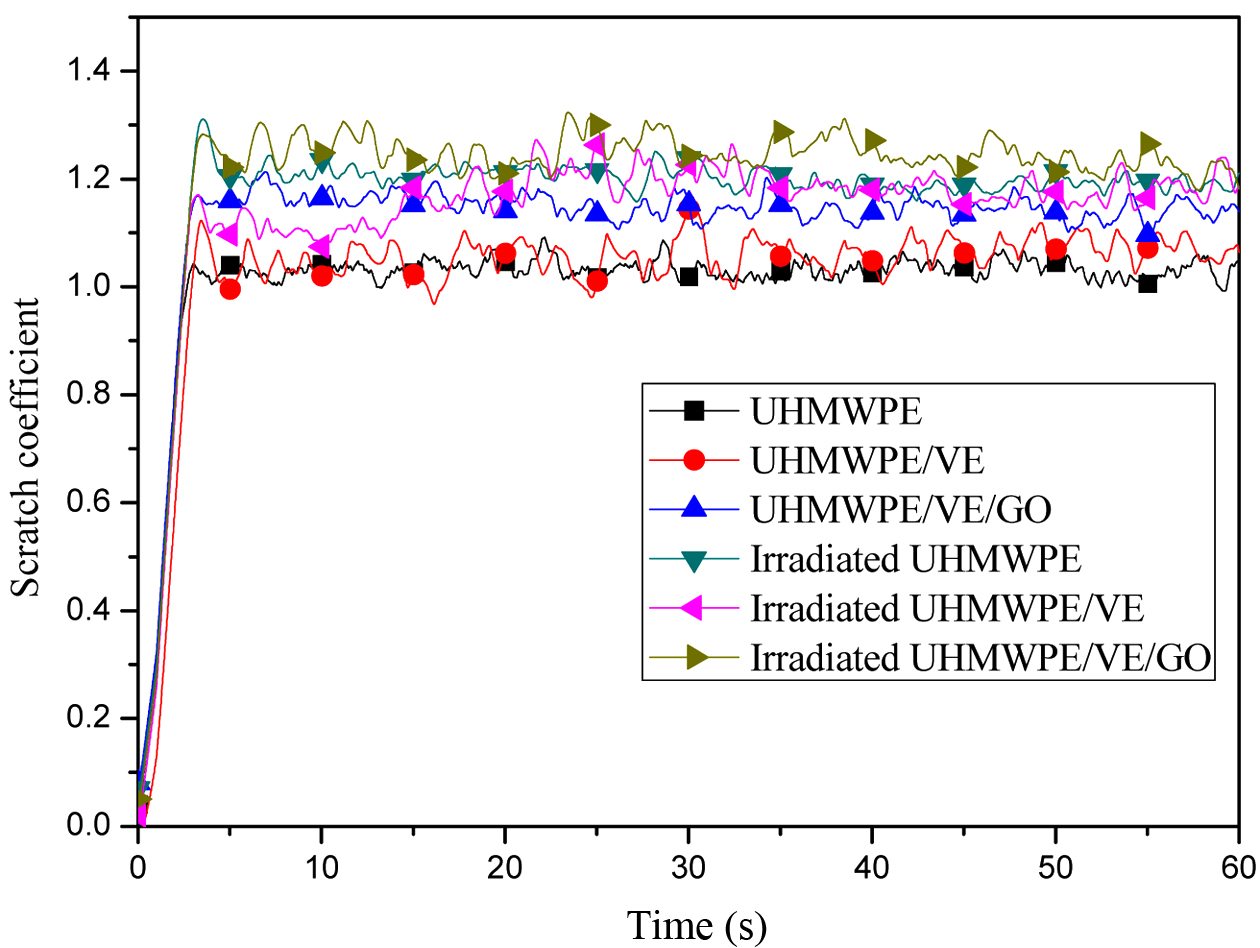
|
Figure 9 Scratch coefficient of different materials. |

|
Figure 10 Scratch morphology of different materials. |
The emphasis of this work is the study of GO improving the mechanical
properties of irradiation cross-linked UHMWPE/VE composites. Adding GO into
UHMWPE/VE composites before irradiation cross-linking provided a practicable
approach to improve mechanical properties of irradiated UHMWPE/VE composites
while obtaining high hardness and scratch resistance. In this study,
irradiation cross-linked UHMWPE/VE composite was enhanced by filling GO. VE
filling decreased the gel content, resulting in a slight decrease of hardness
and scratching performance. The addition of GO slightly affected the melting
point and gel content of the composite, but to a small extent. However,
crystallinity shows distinct improvement. Due to the great mechanical
properties of GO, the hardness and scratch resistance improved 19.8% and 28.1%,
respectively. Meanwhile, irradiation cross-linking and GO filling can synergistically
enhance the thermal stability and mechanical properties of UHMWPE/VE
composites.
- 1. P. Bracco and E. Oral, Clin. Orthop. Relat. Res., 469, 2286 (2011).
-

- 2. D. H. Yang, G. H. Yoon, G. J. Shin, S. H. Kim, J. M. Rhee, G. Khang, and H. B. Lee, Macromol. Res., 13, 120 (2005).
-

- 3. H. S. Lee, J. H. Park, J. H. Yim, H. J. Seo, and T. W. Son, Polym. Korea, 39, 23 (2015).
-

- 4. E. Oral, B. W. Ghali, S. L. Rowell, B. R. Micheli, A. J. Lozynsky, and O. K. Muratoglu, Biomaterials, 31, 7051 (2010).
-

- 5. E. Oral, E. S. Greenbaum, A. S. Malhi, W. H. Harris, and O. K. Muratoglu, Biomaterials, 26, 6657 (2005).
-

- 6. E. Oral, C. A. G. Godleski, A. J. Lozynsky, A. S. Malhi, and O. K. Muratoglu, Biomaterials, 30, 1870 (2009).
-

- 7. B. N. Doshi, B. Ghali, B. C. Godleski, A. J. Lozynsky, E. Oral, and O. K. Muratoglu, Macromol. Mater. Eng., 300, 458 (2015).
-

- 8. J. Fu, B. N. Doshi, E. Oral, and O. K. Muratoglu, Polymer, 54, 199 (2013).
-

- 9. C. Lee, X. Wei, J. W. Kysar, and J. Hone, Science, 321, 385 (2008).
-

- 10. A. K. Geim, Science, 324, 1530 (2009).
-

- 11. C. N. Rao, A. K. Sood, K. Subrahmanyam, and A. Govindaraj, Angew. Chem. Int. Ed., 48, 7752 (2009).
-

- 12. X. Zhou and F. Liang, Curr. Med. Chem., 21, 855 (2014).
-

- 13. W. C. Pang, Z. F. Ni, G. M. Chen, G. D. Huang, H. D. Huang, and Y. W. Zhao, RSC Adv., 5, 63063 (2015).
-

- 14. Z. F. Ni, W. C. Pang, G. M. Chen, P. P. Lu, and S. H. Qian, Russ. J. Appl. Chem., 90, 1876 (2017).
-

- 15. G. D. Huang, Z. F. Ni, G. M. Chen, W. C. Pang, and Y. W. Zhao, Int. J. Polym. Anal. Charact., 21, 417 (2016).
-

- 16. G. Huang, Z. Ni, G. Chen, and Y. Zhao, Int. J. Polym. Sci., 2016, 2618560 (2016).
-

- 17. Y. F. Chen, Y. Y. Qi, Z. X. Tai, X. B. Yan, F. L. Zhu, and Q. J. Xue, Eur. Polym. J., 48, 1026 (2012).
-

- 18. Z. X. Tai, Y. F. Chen, Y. F. An, X. B. Yan, and Q. J. Xue. Tribol. Lett., 46, 55 (2012).
-

- 19. S. Su, R. Joffe, J. L. Tipper, and N. Emami, Composites B, 78, 18 5 (2015).
-

- 20. W. S. Hummers and R. E. Hummers, J. Am. Chem. Soc., 80, 1339 (1958).
-

- 21. Annual Book of ASTM Standards, ASTM D2765-01 (2001).
- 22. B. Wunderlich, Macromol. Phys., New York, Academic Press, Vol 3 (1980).
- 23. J. W. Gooch, ISO 2039-B, 61, 399 (2011).
-

- 24. G. M. Chen, Z. F. Ni, and S. H. Qian, Ind. Lubr. Tribol., 5, 68 (2016).
-

- 25. W. C. Pang, J. L. Wu, Q. F. Zhang, and G. F. Li, RSC Adv., 7, 55536 (2017).
-

- 26. V. Premnath, W. H. Harris, M. Jasty, and E. W. Merrill, Biomaterials, 17, 1741 (1996).
-

- 27. C. Turner, Alexander, and Tomohiro, J. Biomech. Sci. Eng., 10, 1 (2015).
- 28. A. George, H. D. Ngo, and A. Bellare, J. Mech. Behav. Biomed. Mater., 40, 406 (2014).
-

- 29. E. Kolanthai, S. Bose, K. S. Bhagyashree, S. V. Bhat, K. Asokan, D. Kanjilal, and K. Chatterjee, Phys. Chem. Chem. Phys., 17, 22900 (2015).
-

- 30. K. P. Hyun and Y. C. Nho, Radiat. Phys. Chem., 60, 79 (2001).
-

- 31. F. J. Buchanan, J. R. White, B. Sim, and S. Downes, J. Mater. Sci.-Mater. Med., 12, 29 (2001).
-

- 32. J. H. Choe, J. Jeon, M. E. Lee, J. J. Wie, H. J. Jin, and Y. S. Yun, Nanoscale, 10, 2025 (2018).
-

- 33. S. K. Kim, J. J. Wie, Q. Mahmood, and H. S. Park, Nanoscale, 6, 7430 (2014).
-

- Polymer(Korea) 폴리머
- Frequency : Bimonthly(odd)
ISSN 0379-153X(Print)
ISSN 2234-8077(Online)
Abbr. Polym. Korea - 2023 Impact Factor : 0.4
- Indexed in SCIE
 This Article
This Article
-
2020; 44(5): 589-595
Published online Sep 25, 2020
- 10.7317/pk.2020.44.4.589
- Received on Oct 15, 2019
- Revised on Dec 29, 2019
- Accepted on Jun 1, 2020
 Services
Services
- Full Text PDF
- Abstract
- ToC
- Acknowledgements
Introduction
Experimental
Results and Discussion
Conclusions
- References
Shared
 Correspondence to
Correspondence to
- Jitai Han
-
Binjiang College, Nanjing University of Information Science & Technology, Wuxi 214105, China
- E-mail: hanjitai@hotmail.com
- ORCID:
0000-0003-3081-5764









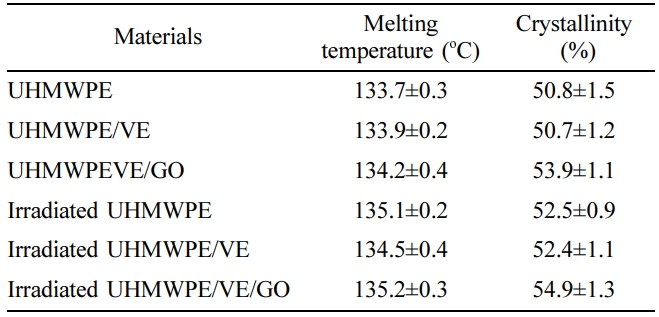
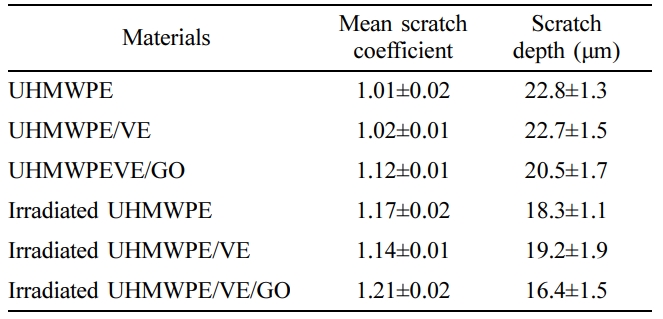
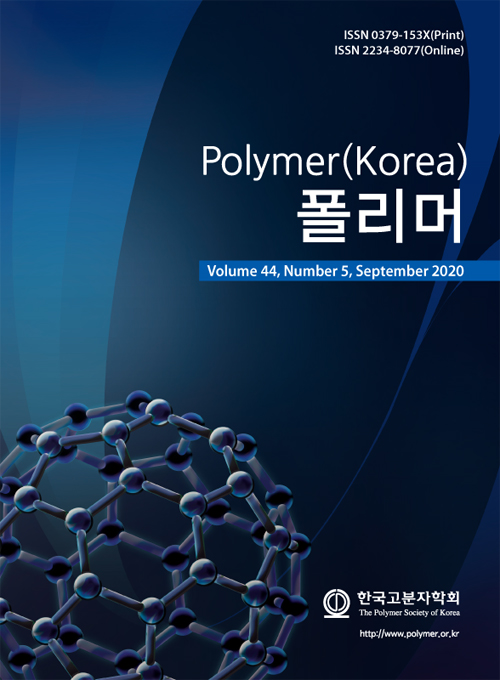
 Copyright(c) The Polymer Society of Korea. All right reserved.
Copyright(c) The Polymer Society of Korea. All right reserved.